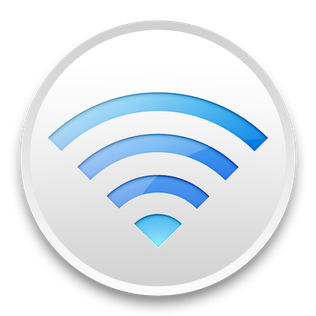
A personal digital assistant (PDA), also known as a handheld PC, is a variety mobile device which functions as a personal information manager. PDAs have been mostly displaced by the widespread adoption of highly capable smartphones, in particular those based on iOS and Android, seeing a rapid decline in use after 2007.
Darwin is the core Unix operating system of macOS, iOS, watchOS, tvOS, iPadOS, visionOS, and bridgeOS. It previously existed as an independent open-source operating system, first released by Apple Inc. in 2000. It is composed of code derived from NeXTSTEP, BSD, Mach, and other free software projects' code, as well as code developed by Apple.

AirPort is a discontinued line of wireless routers and network cards developed by Apple Inc. using Wi-Fi protocols. In Japan, the line of products was marketed under the brand AirMac due to previous registration by I-O Data.

Bonjour is Apple's implementation of zero-configuration networking (zeroconf), a group of technologies that includes service discovery, address assignment, and hostname resolution. Bonjour locates devices such as printers, other computers, and the services that those devices offer on a local network using multicast Domain Name System (mDNS) service records.
The Internet Printing Protocol (IPP) is a specialized communication protocol for communication between client devices and printers. It allows clients to submit one or more print jobs to the network-attached printer or print server, and perform tasks such as querying the status of a printer, obtaining the status of print jobs, or cancelling individual print jobs.

CUPS is a modular printing system for Unix-like computer operating systems which allows a computer to act as a print server. A computer running CUPS is a host that can accept print jobs from client computers, process them, and send them to the appropriate printer.

Netatalk is a free, open-source implementation of the Apple Filing Protocol (AFP). It allows Unix-like operating systems to serve as file servers for Macintosh computers running macOS or Classic Mac OS.
Operating system Wi-Fi support is defined as the support an operating system includes for Wi-Fi capabilities and usually consists of two pieces: driver level support, and configuration and management support.
iOS is a mobile operating system developed by Apple Inc. and was first released as iPhone OS in June 2007, coinciding with the launch of the first generation iPhone. iPhone OS was renamed iOS following the release of the iPad, starting with iOS 4. With iOS 13, Apple began offering a separate operating system, iPadOS, for the iPad. iOS is also the foundation of the newer audioOS and tvOS, and shares some of its code with macOS. New iOS versions are released every year alongside new iPhone models. From its launch in 2007 until 2010, this occurred in June or July, since then, new major versions are released in September or October. Since the launch of the iPhone in June 2007, there have been 17 major releases of iOS. The current major version of iOS is iOS 17, released in September 2023.
Apple's Bonjour Sleep Proxy service is an open source component of zero-configuration networking, designed to assist in reducing power consumption of networked electronic devices.

AirPlay is a proprietary wireless communication protocol stack/suite developed by Apple Inc. that allows streaming between devices of audio, video, device screens, and photos, together with related metadata. Originally implemented only in Apple's software and devices, it was called AirTunes and used for audio only. Apple has since licensed the AirPlay protocol stack as a third-party software component technology to manufacturers that build products compatible with Apple's devices.

Google Cloud Print was a Google service that allowed users to print from any Cloud Print-aware application on any device in the network cloud to any printer with native support for connecting to cloud print services – without Google having to create and maintain printing subsystems for all the hardware combinations of client devices and printers, and without the users having to install device drivers to the client, but with documents being fully transmitted to Google. Starting on July 23, 2013 it allowed printing from any Windows application, if Google Cloud Printer was installed on the machine.

AirDrop is a proprietary wireless ad hoc service in Apple Inc.'s iOS and macOS operating systems, introduced in Mac OS X Lion and iOS 7, which can transfer files among supported Macintosh computers and iOS devices by means of close-range wireless communication. This communication takes place over Apple Wireless Direct Link 'Action Frames' and 'Data Frames' using generated link-local IPv6 addresses instead of the Wi-Fi chip's fixed MAC address.

HP ePrint is a term used by Hewlett-Packard to describe a variety of printing technologies developed for mobile computing devices, such as smartphones, tablet computers, and laptops.
The following outline of Apple Inc. is a topical guide to the products, history, retail stores, corporate acquisitions, and personnel under the purview of the American multinational corporation Apple Inc.
The iPad Mini is a line of mini tablet computers designed, developed, and marketed by Apple Inc. It is a sub-series of the iPad line of tablets, with screen sizes of 7.9 inches and 8.3 inches. The first-generation iPad Mini was announced on October 23, 2012, and was released on November 2, 2012, in nearly all of Apple's markets. It featured similar internal specifications to the iPad 2, including its display resolution.

A wireless keyboard is a computer keyboard that allows the user to communicate with computers, tablets, or laptops with the help of radio frequency (RF), such as WiFi and Bluetooth or with infrared (IR) technology. It is common for wireless keyboards available these days to be accompanied by a wireless mouse.

The iPad Mini 2 is a tablet computer produced and marketed by Apple Inc. It has a nearly identical design to its predecessor the first-generation iPad Mini, but features internal revisions such as the addition of the A7 system-on-a-chip and 2,048 x 1,536 resolution Retina Display. Internally, the second-generation iPad Mini has nearly the same hardware as its sibling device, the iPad Air. Apple released the second-generation iPad Mini in space gray and silver colors on November 12, 2013.

The first-generation iPad Mini is a mini tablet computer designed, developed, and marketed by Apple Inc. It was announced on October 23, 2012, as the fourth major product in the iPad line and the first of the iPad Mini line, which features a reduced screen size of 7.9 inches (20 cm), in contrast to the standard 9.7 inches (25 cm). It features similar internal specifications to the iPad 2, including its display resolution.












